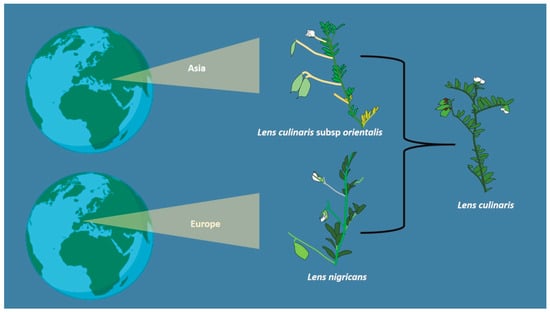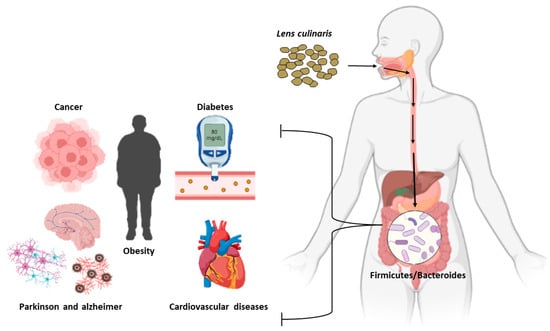The legume family includes approximately 19,300 species across three large subfamilies, of which Papilionoideae stands out with 13,800 species. Lentils were one of the first crops to be domesticated by humans. They are diploid legumes that belong to the Papilionoidea subfamily and are of agricultural importance because of their resistance to drought and the fact that they grow in soil with a pH range of 5.5–9; therefore, they are cultivated in various types of soil, and so they have an important role in sustainable food and feed systems in many countries. In addition to their agricultural importance, lentils are a rich source of protein, carbohydrates, fiber, vitamins, and minerals. They are key to human nutrition since they are an alternative to animal proteins, decreasing meat consumption.
1. Introduction
Legumes comprise approximately 750 genera and 19,300 species. They are primarily herbs, shrubs, vines, and trees
[1]. Currently, three large groups of subfamilies are recognized: Mimosoideae, with 4 tribes and 3270 species; Papilionoideae, with 28 tribes and 13,800 species; and Caesalpinoidea, with 4 tribes and 2250 species
[2]. The lentil (
Lens culinaris Medik.) is a diploid legume (2
n = 14) with a large genome of 4063 Mbp, is phylogenetically nested within the tribe Vicieae, and belongs to the Papilionoideae subfamily of the Fabaceae family
[3].
The importance of lentil cultivation lies in its resistance to drought and its ability to grow in a wide range of soils, from light to heavy, with a pH of 5.5–9; therefore, this legume production presents an encouraging panorama. Due to its low cultivation costs, it could become a magnificent option for the diversification of crops, taking advantage of marginal soils that otherwise would be left out of agricultural activities
[4]. Regarding nutritional aspects, lentils contain proteins, carbohydrates, oils, and ash in proportions of 23%, 59%, 1.8%, and 0.2%, respectively, and also provide iron, calcium, phosphorus, magnesium, vitamin A, and vitamin B
[5][6][5,6]. Furthermore, worldwide lentil production has increased annually to an estimated 5.6 million hectares
[7]. Lentils are important in the diet of low-income populations in developing countries because they replace animal proteins
[8]. Another characteristic of legumes is their ability to fix atmospheric nitrogen (N
2) through symbiosis with bacteria called rhizobia through the formation of specialized structures called nodules, which is advantageous for growth in soils with low N
2 content
[9].
Lentils were possibly the first crop to be domesticated approximately 11,000 BP in the Fertile Crescent
[10]. When agriculture spread from the Fertile Crescent, lentils were among the first crops introduced to Europe and Egypt
[11]. However, neither archaeological nor genomic investigations have found the exact location of lentil domestication. Still, it is believed to have been near the east, in the Franchthi cave in Greece dated to 11,000 BC and at Tel Mureybet in Syria 8500–7500 years BC, in a region known as “The cradle of agriculture”
[11].
Lens culinaris subsp.
Orientalis (Boiss.) is a wild progenitor of the cultivated species (
Figure 1) and is found in Asia, Central Asia, and Cyprus. Another
Lens culinaris (Medik.) wild progenitor is
Lens nigricans (M. Bieb.) and its domestication could be located in southern Europe
[12]. Despite this, restriction fragment length polymorphism (RFLP) analysis has shown that the taxon with the greatest genetic identity to
Lens culinaris (Medik.) was
Lens culinaris subsp.
Orientalis (Boiss.) followed, followed by
Lens odemensis (L.),
Lens ervoides (Brign.), and
Lens nigricans (M. Bieb.)
[13]. Additionally,
Lens nigricans (M. Bieb.) shows a level of polymorphism that suggests that it may have undergone domestication
[14].
Figure 1. Origin of Lens culinaris. The origin of the lentil dates back to 11,000 BP in the Fertile Crescent, with L. culinaris subsp orientalis (Boiss.) being the wild progenitor. This indicates that this legume was domesticated in Asia; however, other evidence points to the progenitor of the lentil being L. nigricans (M. Bieb.), whose domestication occurred in Europe.
Wild species of the genus
Lens are distributed in the Mediterranean Basin:
Lens culinaris subsp.
odemensis (L). is restricted to the east, from Turkey to Syria and Palestine
[15], while
Lens culinaris subsp.
tomentosus (Ladiz.) has only been found in Libya. In contrast,
Lens ervoides (Brign.) is distributed from Spain to Ukraine and to the south of Jordan.
Lens nigricans (M. Bieb.) grows in small colonies on stony slopes and rocky soils and in clearings of pine forests
[16]; it has a western distribution from Spain to Turkey and southern distribution to Morocco
[17] but is also found in Ethiopia and Uganda. Finally,
Lens lamottei (Czefr.) grows in Morocco
[18].
Therefore, the regions with the highest species richness of the genus
Lens (with three and four species) are the Crimean Peninsula, southeastern Turkey, and the eastern Mediterranean countries of Syria, Jordan, Israel, and Palestine. Regions with two species of the genus
Lens include Spain, the Balkans, Albania, Greece, and western Turkey
[19].
Lens culinaris (Medik.) is the only cultivated species
[18] for which wild species, which serve as genetic reserves, are threatened by poor competitiveness and low palatability, along with the fact that they occur in small, isolated populations
[17]. It is necessary to promote the maintenance and care of these lentil genetic reservoirs to preserve the evolutionary history of this legume and not only focus on its economic and agricultural impact worldwide.
2. Effect of Lentil Consumption on Human Health
Food scarcity causes nutritional deficiencies in humans, coupled with a deficient diet lacking macro- and micronutrients such as proteins, fats, vitamins, and minerals, resulting in protein malnutrition. Low-digestible carbohydrates, also called prebiotics, are substrates that microorganisms in the host’s digestive system use to confer health benefits
[20][47].
Microorganisms in the human body comprise four main Phyla: Firmicutes, Bacteroides, Actinomycetes, and Proteobacteria. The Firmicutes/Bacteroides ratio is an important parameter to reflect disturbances of the gut microbiota, which can cause disease
[21][48]. The intestinal microbiota regulates nervous, endocrine, and immune system communication through the brain–gut connection, which affects the appearance and development of central nervous system diseases, especially Parkinson’s and Alzheimer’s diseases
[22][49]. Additionally, metabolites produced by the microbiota, especially trimethylamine oxide, bile acids, and short-chain fatty acids, can induce the development of cardiovascular diseases, such as hypertension and atherosclerosis
[23][50]. Finally, the gut microbiota has been associated with metabolic diseases such as obesity and diabetes, as well as gastrointestinal diseases such as inflammatory bowel disease and colon cancer
[24][51].
A previous study in a rat model
[25][52] reported the profile of prebiotic carbohydrates after removing protein and fats from the lentil seed (
Figure 2). Among the simple sugars, sucrose was the most abundant (1.2–2.3 g/100 g), followed by glucose (21–61 mg/100 g), fructose (0.2–21.9 mg/100 g), mannose (1.2–7.9 mg/100 g), and rhamnose (0.5–1.0 mg/100 g). Among sugar alcohols, sorbitol concentrations were the highest (0.6–0.7 g/100 g), followed by mannitol (9–31 mg/100 g) and xylitol (14–31 mg/100 g). In the case of the oligosaccharides of the raffinose family, stachyose was more abundant (2236–2348 mg/100 g) than raffinose (0.4–0.6 g/100 g) and verbascose (0.6–1.8 g/100 g). In contrast, lentils contain more kestose than nistose. Other prebiotic carbohydrates present were arabinose (2.4–2.6 g/100 g), xylose (1.9 g/100 g), and cellulose (0.6 g/100 g).
Figure 2. Effect of lentil consumption on human health. Due to lentils containing prebiotics, which serve as a substrate for microorganisms such as Firmicutes and Bacteroidetes (whose ratio is an important parameter that reflects intestinal disturbances) present in the human intestine, the consumption of this legume protects against various diseases like Parkinson’s, Alzheimer’s, diabetes, obesity, cancer, and cardiovascular diseases.
Considering the importance of prebiotic carbohydrates in the maintenance of the intestinal microbiota, which is involved in the development of a large number of diseases in humans, the consumption of lentils plays a key role in the protection and maintenance of intestinal microbiota health. It has been linked to a reduction in hypertension, cardiovascular diseases, diabetes mellitus, and cancer
[26][53].
Much of the increase in lentil cultivation is due to its nutritional contribution. Lentils are an important source of protein in developing countries as well as an excellent source of complex carbohydrates, fibers, vitamins, and minerals
[27][54]. Other abundant macronutrients in lentils are proteins, among which globulin predominates, comprising 47% of the total seed, and a high amount of albumin
[28][55]. Therefore, a protein-rich diet based on legumes is a viable and sustainable option that helps prevent malnutrition in developing countries and is an alternative to animal proteins, which are more expensive and have greater harmful effects on the environment
[29][56].
Among
Lens spp., the accession ILWL47 was identified as having a high protein content, belonging to the species
Lens ervoides (Brign.)
[30][57]. Another lentil accession, IC317520, was identified as having high protein, sugar, and starch content. The crossing of these two varieties could generate offspring with improved nutritional content
[31][58]. Another approach for improving lentils nutritionally and agriculturally is through mutations; a mutant variety of lentils, NIA-MASOOR-5, has a high protein content, high yield, and resistance to diseases
[32][59]. Considering this background,
itwe can
be highlight
ed that the efforts to improve the nutritional content of lentils have focused on maintaining nutritional security, improving human health, and providing highly nutritious and low-cost foods.


